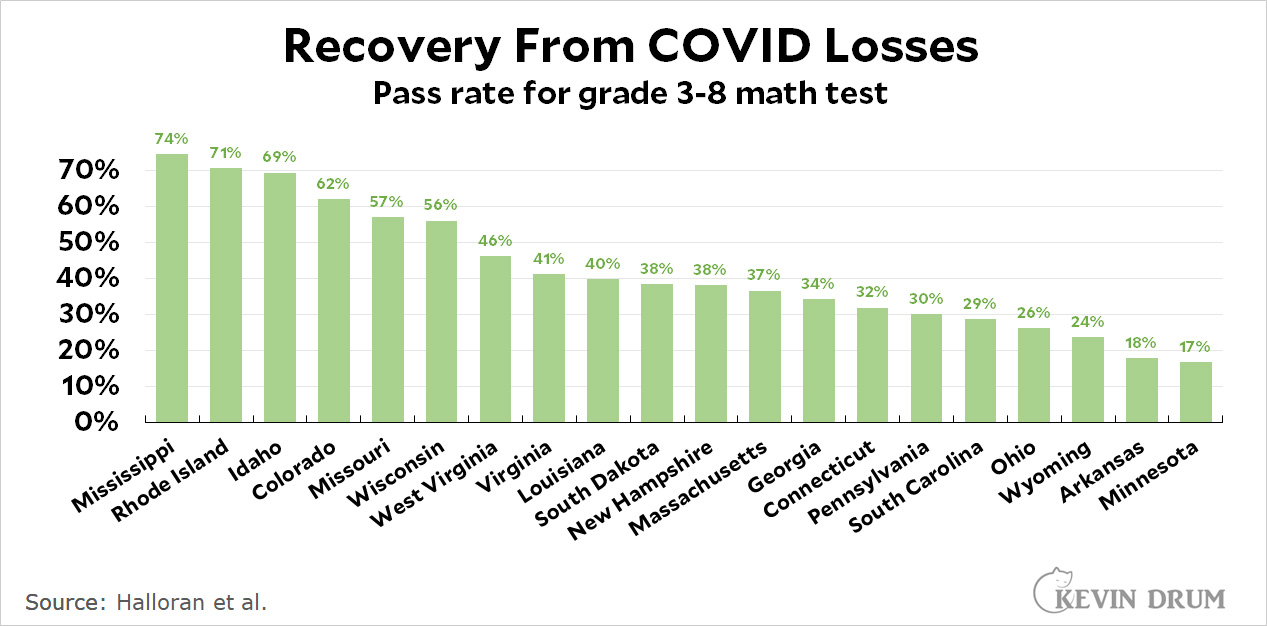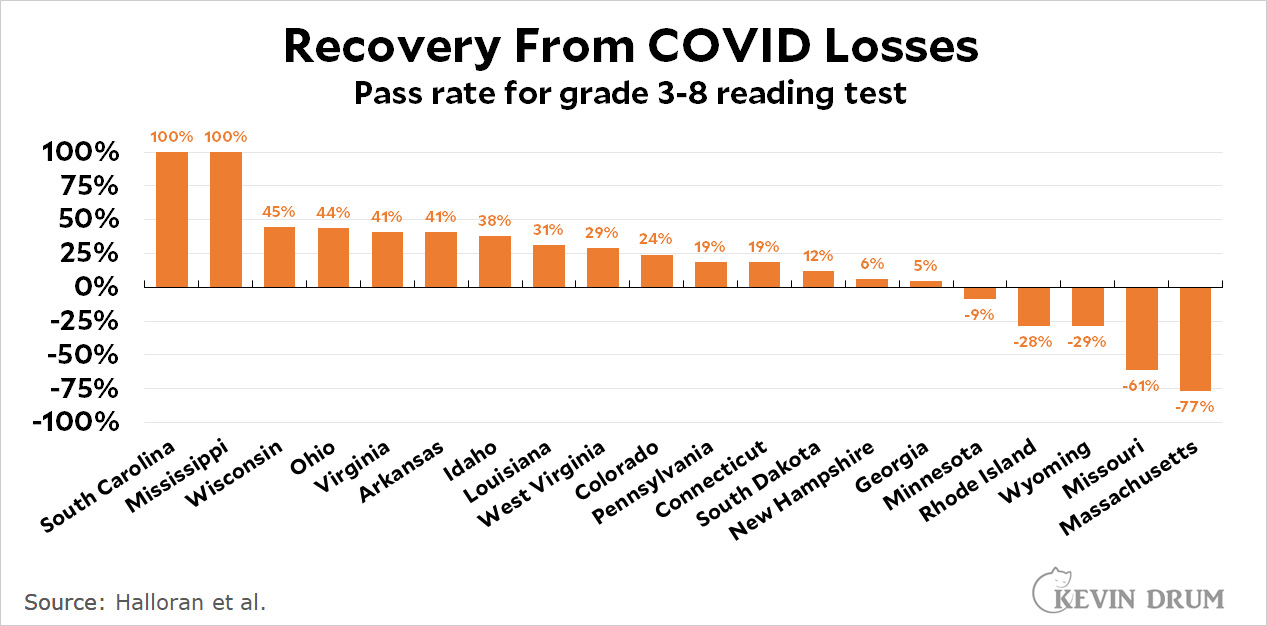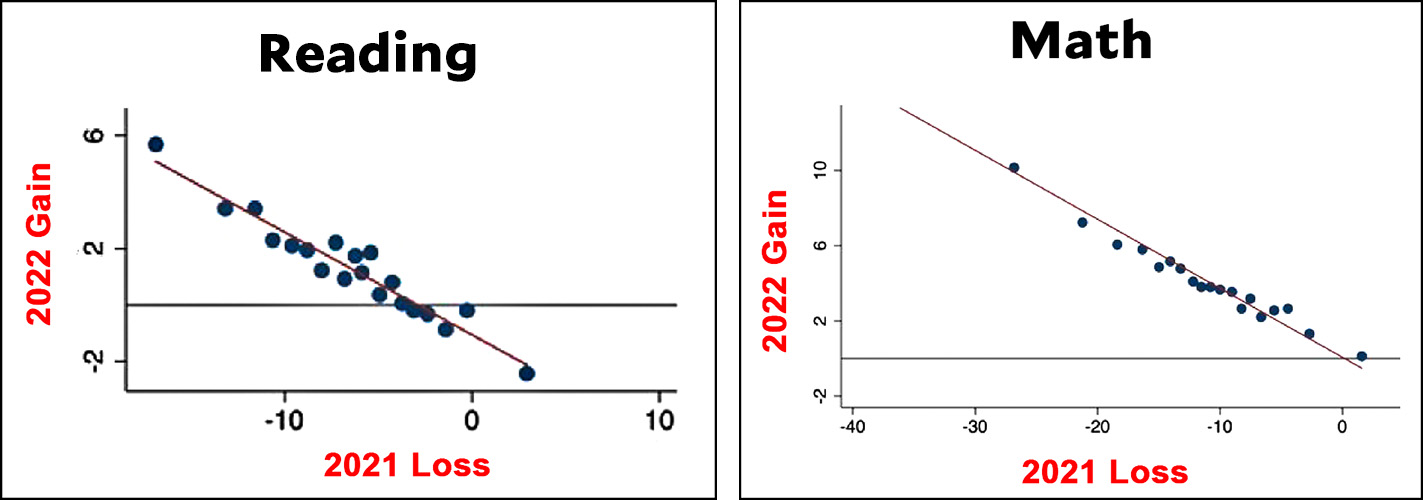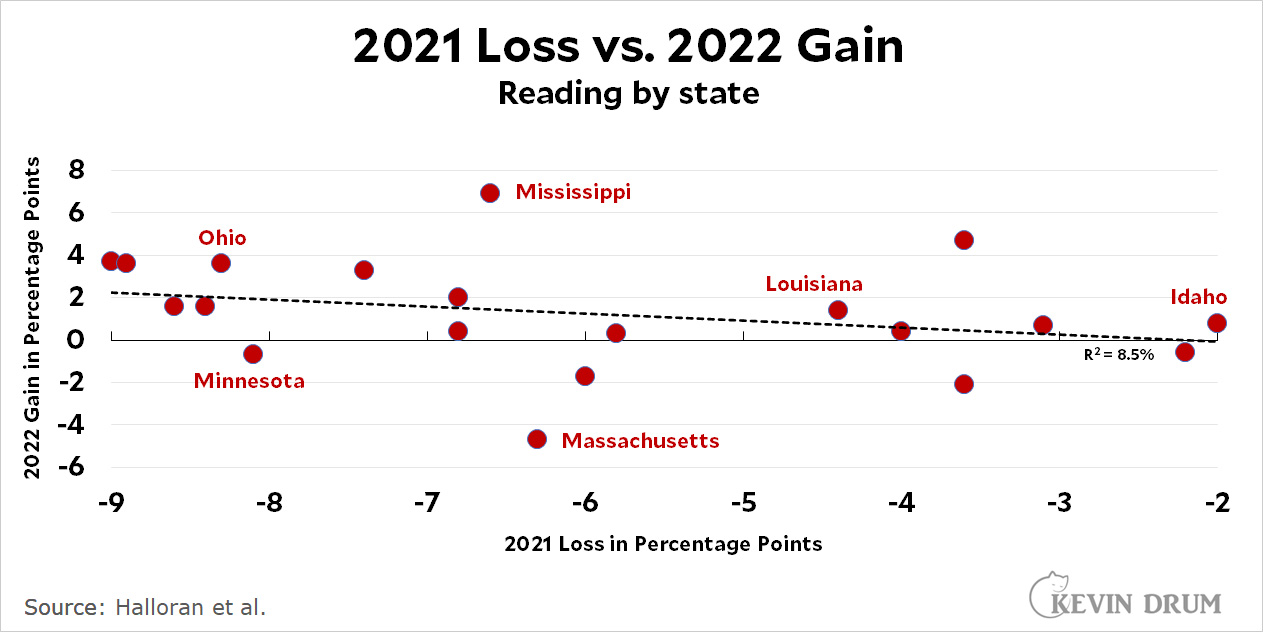It's well documented that schoolchildren lost a significant amount of learning during the COVID-19 pandemic. A new NBER study attempts to figure out how much of that they made up in 2022. Their metric is the percentage of students who scored "proficient" on state tests. Here are the results for math:
 Of the 20 states in the study, Mississippi made the strongest recovery. Their pass rate is now close to what it was before COVID. Minnesota was the worst. However, every state showed at least some recovery. The same is not true of reading:
Of the 20 states in the study, Mississippi made the strongest recovery. Their pass rate is now close to what it was before COVID. Minnesota was the worst. However, every state showed at least some recovery. The same is not true of reading:
 Two states, South Carolina and Mississippi, have made up all their losses and now have a higher pass rate than before COVID. However, five states continued to decline. Massachusetts went from a 52% pass rate to 45% during COVID and then dropped 41% in 2022.
Two states, South Carolina and Mississippi, have made up all their losses and now have a higher pass rate than before COVID. However, five states continued to decline. Massachusetts went from a 52% pass rate to 45% during COVID and then dropped 41% in 2022.
The size of the difference between states is remarkable. But this chart suggests it might be easy to explain:
 This is a binned scatterplot done at the district level (not the state level). The conclusion is plain: the bigger the loss in 2021, the bigger the gain in 2022. However, the correlation is extremely tight, which makes me a little suspicious—especially when we see no such thing at the state level:
This is a binned scatterplot done at the district level (not the state level). The conclusion is plain: the bigger the loss in 2021, the bigger the gain in 2022. However, the correlation is extremely tight, which makes me a little suspicious—especially when we see no such thing at the state level:
 There's only the slightest correlation between gains and losses at the state level, which is where education policy is set. So this probably doesn't explain much. Furthermore, the study's authors dug into a bunch of other possible explanations for the wide variance in state results, but none of them panned out. For now, it's a mystery.
There's only the slightest correlation between gains and losses at the state level, which is where education policy is set. So this probably doesn't explain much. Furthermore, the study's authors dug into a bunch of other possible explanations for the wide variance in state results, but none of them panned out. For now, it's a mystery.

I think there is a statistical error in the 2022 gain vs 2021 loss plots. 2022 gain is X2022-X2021. 2021 loss is X2020-X2021. So the plot amounts to X2021 against itself, with added noise, and that is why the correlation is so high. There still may be something going on, but this approach doesn't reveal it.
I think a pretty obvious question is what was their quality before COVID. To me it seems intuitive that the states with the worst performance wouldn't have declined as much since their schools were already bad they aren't missing as much and now would get back to their mediocre prior level faster, while the places with the best schools would have the most decline and take longer to recover.
Are these tests actually measuring the same thing, pre-pandemic and current?
I'm skeptical that Mississippi, of all states, didn't simply change their tests and that's why more students are now passing than before (and South Carolina, and for that matter all the states - are they all using the same tests as before?). If the measurement tool (the test) didn't change, then that's great! But I'd want confirmation of that before giving them any credit.
I was going to ask the same thing, and are all these states using the same test in the first place, or have the same criteria for proficiency?
As someone else mentioned, the report doesn't indicate what the pass rates were before the pandemic. These comparisons of 2019 and 2022 of 4th grade match scores from the National Assessment of Educational Progress seems to question this study, at least in regard to MS. of 4th grade match scores. https://www.nationsreportcard.gov/mathematics/states/scores/?grade=4
https://www.nationsreportcard.gov/mathematics/states/scores/?grade=8
https://www.nationsreportcard.gov/mathematics/states/scores/?grade=8
I'd be interested in knowing what the test opt-out rates were before and after. Anecdotally, there were a TON of very angry upper-middle-class White women in my social sphere who thought having their kids take a standardized test post-covid was tantamount to child abuse. I'm curious to know if that was just hot air, or perhaps enough to shift aggregate scores.
The scale of the change in test results for both the 'loss' during covid and the 'gain' following Covid appears to indicate that these tests dont really measure learning.
Google paid 99 dollars an hour on the internet. Everything I did was basic Οnline w0rk from comfort at hΟme for 5-7 hours per day that I g0t from this office I f0und over the web and they paid me 100 dollars each hour. For more details visit this article... https://createmaxwealth.blogspot.com